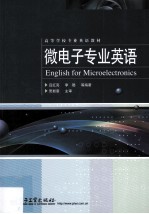图书介绍
微电子专业英语【2025|PDF|Epub|mobi|kindle电子书版本百度云盘下载】

- 吕红亮,李聪等编著;贾新章主审 著
- 出版社: 北京:电子工业出版社
- ISBN:9787121177606
- 出版时间:2012
- 标注页数:326页
- 文件大小:41MB
- 文件页数:338页
- 主题词:微电子技术-英语-高等学校-教材
PDF下载
下载说明
微电子专业英语PDF格式电子书版下载
下载的文件为RAR压缩包。需要使用解压软件进行解压得到PDF格式图书。建议使用BT下载工具Free Download Manager进行下载,简称FDM(免费,没有广告,支持多平台)。本站资源全部打包为BT种子。所以需要使用专业的BT下载软件进行下载。如BitComet qBittorrent uTorrent等BT下载工具。迅雷目前由于本站不是热门资源。不推荐使用!后期资源热门了。安装了迅雷也可以迅雷进行下载!
(文件页数 要大于 标注页数,上中下等多册电子书除外)
注意:本站所有压缩包均有解压码: 点击下载压缩包解压工具
图书目录
Session 1 Introduction to Semiconductor1
1.1 What is Semiconductor1
1.2 Classification of Semiconductor3
Reading Materials3
Session 2 Crystal Structure9
2.1 Primitive Cell and Crystal Plane9
2.2 Atomic Bonding11
Reading Materials12
Session 3 Band Model17
3.1 Introduction to Quantum Mechanics17
3.2 Band18
3.3 Effective Mass Theory19
Reading Materials20
Session 4 The Semiconductor in Equilibrium23
4.1 Charge Carriers in Semiconductor23
4.2 Intrinsic Semiconductor25
4.3 Extrinsic Semiconductor26
Reading Materials28
Session 5 Carrier Transport32
5.1 Overview of Carrier Transport32
5.2 Low Field Transport33
5.3 High Field Transport35
5.4 Diffusion Current35
Session 6 Nonequilibrium Excess Carriers in Semiconductor41
6.1 Recombination41
6.2 Minority Carrier Lifetime43
6.3 Ambipolar Transport44
Reading Materials45
Session 7 The pn Junction(Ⅰ)48
7.1 Introduction48
7.2 Basic Structure of the pn Junction48
7.3 Energy Bands for a pn Junction49
7.4 Ideal Current-Voltage Relationship49
7.5 Characteristics of a Practical Diode50
Reading Materials51
Session 8 The pn Junction(Ⅱ)56
8.1 Breakdown in pn Junction56
8.2 Small-Signal Diffusion Resistance of the pn Junction56
8.3 Junction Capacitance57
8.4 Diffusion or Storage Capacitance58
8.5 Diode Transients59
8.6 Circuit Models for Junction Diodes59
Reading Materials60
Session 9 Metal-Semiconductor Contacts64
9.1 Schottky Contacts64
9.2 Ohmic Contacts69
Reading Materials70
Session 10 Heterojunctions74
10.1 Strain and Stress at Heterointerfaces74
10.2 Heterojunction Materials75
10.3 Energy-Band Diagrams77
Reading Materials78
Session 11 The Bipolar Junction Transistor(Ⅰ)81
11.1 The Bipolar Junction Transistor Construction81
11.2 Transistor Action81
11.3 Nonideal Effects82
11.4 Base Resistance84
Reading Materials85
Session 12 The Bipolar Junction Transistor(Ⅱ)89
12.1 Breakdown Voltage89
12.2 Frequency Limits of BJT90
12.3 The Schottky-Clamped Transistor91
12.4 Small-signal Transistor Model92
Reading Materials93
Session 13 Basics of MOSFETs96
13.1 Introduction96
13.2 General Characteristics of a MOSFET96
13.3 MOS System97
13.4 Work Function Differences98
13.5 Flat-Band Voltage99
13.6 Threshold Voltage99
Reading Materials100
Session 14 Nonideal Effects of MOSFETs103
14.1 Introduction103
14.2 Effective Mobility103
14.3 Velocity Saturation103
14.4 Channel-length Modulation104
14.5 DIBL104
14.6 Hot-carrier Effect105
14.7 GIDL106
Reading Materials106
Session 15 Advanced MOSFET Devices111
15.1 Introduction111
15.2 Channel Doping Profile111
15.3 Gate Stack111
15.4 Source/Drain Design112
15.5 Schottky-Barrier Source/Drain113
15.6 Raised Source/Drain113
15.7 SOI114
15.8 Three Dimensional Structure115
Reading Materials115
Session 16 Introduction to Integrated Circuits120
16.1 Introduction120
16.2 Size and Complexity of Integrated Circuits121
16.3 Semiconductor Device for Integrated Circuits122
16.4 IC Design Process124
Reading Materials126
Session 17 Analog Integrated Circuits Design131
17.1 Introduction131
17.2 Analog Signal Processing133
17.3 CMOS Technology134
17.4 Amplifiers134
17.5 Differential Amplifiers135
17.6 Operational Amplifiers136
17.7 Characterization of Op Amps137
Reading Materials138
Session 18 Digital Integrated Circuits Design143
18.1 Introduction143
18.2 The Static CMOS Inverter143
18.3 Designing Combinational Logic Gates in CMOS146
Reading Materials151
Session 19 Radio Frequency Integrated Circuits Design156
19.1 Introduction156
19.2 RF System Performance Metrics157
19.3 RF Transceiver Architectures158
19.4 RF Passive Component159
19.5 Receiver159
19.6 Frequency Synthesizer160
19.7 Transmitter161
Reading Materials163
Session 20 Simulation and Verification171
20.1 Introduction171
20.2 SPICE Circuit Simulator171
20.3 Circuit Design Automation with Verilog174
20.4 Verification176
Reading Materials177
Session 21 Introduction to the Semiconductor Technology(Ⅰ)182
21.1 The Development of Semiconductor Technology182
21.2 Wafer Fabrication183
Reading Materials187
Session 22 Introduction to the Semiconductor Technology(Ⅱ)191
22.1 Assembly191
22.2 Metrology193
Reading Materials196
Session 23 Bipolar Technology and GaAs Digital Logic Process199
23.1 Bipolar Technology199
23.2 GaAs Digital Logic Process204
Reading Materials207
Session 24 CMOS Technology212
24.1 CMOS Fabrication Sequence212
24.2 Twin Well and Retrograde Well214
24.3 Isolation215
24.4 Structures that Reduce the Drain Field216
24.5 Gate Engineering216
Reading Materials217
Session 25 Reliability222
25.1 Introduction222
25.2 Failure Modes223
Reading Materials228
参考译文233
第1讲 半导体概述233
1.1 什么是半导体233
1.2 半导体的分类234
第2讲 晶体结构235
2.1 原胞和晶面235
2.2 原子价键236
第3讲 能带模型237
3.1 量子力学简介237
3.2 能带238
3.3 有效质量理论239
第4讲 平衡半导体239
4.1 半导体中的带电载流子240
4.2 本征半导体241
4.3 非本征半导体242
第5讲 载流子输运243
5.1 载流子输运概要243
5.2 低场输运244
5.3 强场输运246
5.4 扩散电流246
第6讲 半导体中的非平衡过剩载流子248
6.1 复合248
6.2 少数载流子寿命249
6.3 双极输运250
第7讲 pn结(Ⅰ)251
7.1 概述251
7.2 pn结的基本结构251
7.3 pn结的能带图251
7.4 理想电流-电压关系252
7.5 实际二极管特性252
第8讲 pn结(Ⅱ)253
8.1 pn结击穿253
8.2 pn结的小信号扩散电阻254
8.3 结电容254
8.4 扩散电容(存储电容)255
8.5 二极管瞬态特性255
8.6 pn结二极管的电路模型256
第9讲 金属—半导体接触256
9.1 肖特基接触256
9.2 欧姆接触259
第10讲 异质结260
10.1 异质界面的应变与应力261
10.2 异质结材料261
10.3 能带图263
第11讲 双极晶体管(Ⅰ)265
11.1 双极晶体管结构265
11.2 晶体管作用265
11.3 非理想效应266
11.4 基区电阻267
第12讲 双极晶体管(Ⅱ)268
12.1 击穿电压268
12.2 双极晶体管的频率特性269
12.3 肖特基钳位晶体管269
12.4 晶体管的小信号模型270
第13讲 MOSFET基础271
13.1 引言271
13.2 MOSFET的一般特征271
13.3 MOS系统272
13.4 功函数差273
13.5 平带电压273
13.6 阈值电压273
第14讲 MOSFET的非理想效应274
14.1 引言274
14.2 有效迁移率274
14.3 速度饱和274
14.4 沟道调制效应274
14.5 漏致势垒降低275
14.6 热电子效应275
14.7 栅感应漏极泄漏276
第15讲 先进的MOSFET器件276
15.1 引言276
15.2 沟道掺杂分布276
15.3 栅叠层277
15.4 源/漏设计277
15.5 肖特基源/漏277
15.6 提升的源/漏278
15.7 SOI(绝缘层上的硅)278
15.8 三维结构279
第16讲 集成电路简介279
16.1 概述279
16.2 集成电路的面积和复杂度280
16.3 集成电路中的半导体器件281
16.4 集成电路设计过程282
第17讲 模拟集成电路设计283
17.1 概述283
17.2 模拟信号处理285
17.3 CMOS工艺286
17.4 放大器286
17.5 差分放大器286
17.6 运算放大器287
17.7 运放的特点288
第18讲 数字集成电路289
18.1 介绍289
18.2 静态CMOS反相器289
18.3 CMOS组合逻辑门的设计291
第19讲 射频集成电路设计294
19.1 概述294
19.2 射频系统的性能指标295
19.3 射频收发机的结构296
19.4 无源射频元件296
19.5 低噪声放大器297
19.6 频率合成器297
19.7 发射机298
第20讲 仿真与验证299
20.1 简介299
20.2 SPICE电路仿真器299
20.3 使用Verilog进行电路的自动设计302
20.4 验证303
第21讲 半导体技术简介(Ⅰ)304
21.1 半导体技术的发展304
21.2 晶片制造304
第22讲 半导体技术简介(Ⅱ)308
22.1 组装308
22.2 测量309
第23讲 双极技术和砷化镓数字逻辑工艺312
23.1 双极技术312
23.2 砷化镓数字逻辑工艺315
第24讲 CMOS工艺317
24.1 CMOS制造流程317
24.2 双阱和倒掺杂阱318
24.3 隔离319
24.4 降低漏端电场的结构319
24.5 栅工程320
第25讲 可靠性321
25.1 概述321
25.2 失效模型322
参考文献326
热门推荐
- 2781093.html
- 1229274.html
- 3558656.html
- 1255383.html
- 25631.html
- 3293216.html
- 2486187.html
- 1472067.html
- 1673546.html
- 3767294.html
- http://www.ickdjs.cc/book_2120400.html
- http://www.ickdjs.cc/book_2474277.html
- http://www.ickdjs.cc/book_2618525.html
- http://www.ickdjs.cc/book_3049197.html
- http://www.ickdjs.cc/book_1612129.html
- http://www.ickdjs.cc/book_588956.html
- http://www.ickdjs.cc/book_240745.html
- http://www.ickdjs.cc/book_2799930.html
- http://www.ickdjs.cc/book_1815394.html
- http://www.ickdjs.cc/book_3646062.html